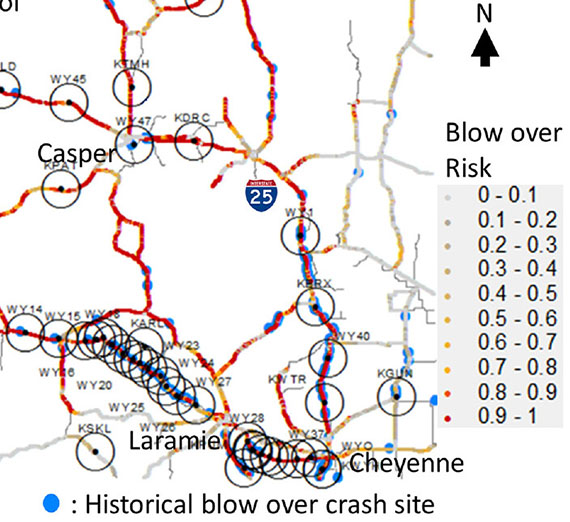Journal Publishes Blow-Over Risk Evaluation System

"Blow-Over Risk Evaluation System for High-Profile Light-Weight Vehicles on Wyoming Highways" has been published in the December 2023 edition of Transportation Research Record. The paper's co-authors include Civil Engineering Professor Rhonda Young, Ph.D. and research student Roman Campos ('24, Civil Engineering).
This study is part of a series addressing a need to identify high-risk roadway sections for tractor-trailer blow-over crashes caused by strong winds in Wyoming. By developing a computationally efficient blow-over model, the research quantified incident risk and accurately predicted crash locations within 10 km of weather stations. The model can be used for real-time risk prediction, helping road managers and travelers make informed decisions.
Research was supported by the Wyoming Department of Transportation.
Transportation safety is the primary focus of Dr. Young's Transportation Lab, part of the Civil Engineering department.
Ohara, N, A Neupane, K Ahlenius, R Young, R Campos (2023) “Blow-Over Risk Evaluation System for High-Profile Light-Weight (HPLW) Vehicles on Wyoming,” Transportation Research Record 2677(12). DOI:10.1177/03611981231168118
Abstract: Tractor-trailer blow-over crashes caused by strong winds in Wyoming, U.S., can damage roadways, delay goods, and threaten the safety of all members of the traveling public. Identifying roadway sections with high blow-over risk is important for taking appropriate and targeted precautions to avoid these serious problems. This study utilizes a vehicle blow-over model compiled from previous research to quantify incident risk on Wyoming roads and test the appropriateness of existing risk assessments. Data about blow-over crashes from 2012 to 2020 were used to calibrate a new statewide model, and this model was leveraged to observe the evolution of blow-over risk during high wind periods from past blow-over crash events. The results from this model show that blow-over crashes occur in specific zones with elevated risk variables. The model was also especially precise at predicting crash locations within 10 km of nearby weather stations. This computationally efficient model can now be used for real time blow-over risk prediction using road weather information system environmental sensor stations throughout Wyoming. This dynamic risk assessing tool, continuously updated online, can help travelers with high-profile light-weight vehicles through existing traveler information systems, and this model also serves as an addition to the typical wind gust data used by decision-makers managing Wyoming roads.

